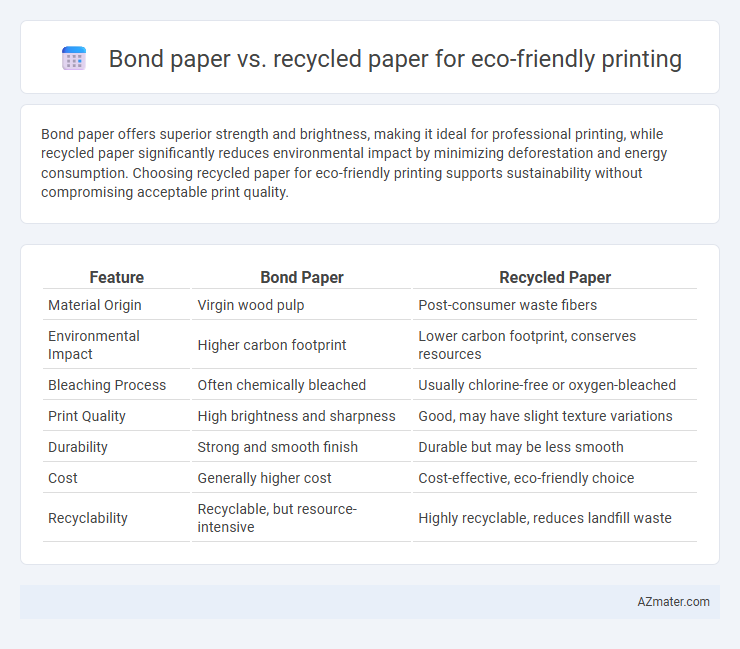Bond paper offers superior strength and brightness, making it ideal for professional printing, while recycled paper significantly reduces environmental impact by minimizing deforestation and energy consumption. Choosing recycled paper for eco-friendly printing supports sustainability without compromising acceptable print quality.
Table of Comparison
| Feature | Bond Paper | Recycled Paper |
|---|---|---|
| Material Origin | Virgin wood pulp | Post-consumer waste fibers |
| Environmental Impact | Higher carbon footprint | Lower carbon footprint, conserves resources |
| Bleaching Process | Often chemically bleached | Usually chlorine-free or oxygen-bleached |
| Print Quality | High brightness and sharpness | Good, may have slight texture variations |
| Durability | Strong and smooth finish | Durable but may be less smooth |
| Cost | Generally higher cost | Cost-effective, eco-friendly choice |
| Recyclability | Recyclable, but resource-intensive | Highly recyclable, reduces landfill waste |
Introduction to Eco-Friendly Printing
Eco-friendly printing prioritizes sustainability by minimizing environmental impact through the use of materials like bond paper and recycled paper. Bond paper, known for its strength and smooth finish, is often sourced from virgin fibers but can be produced sustainably if certified by organizations like FSC. Recycled paper reduces waste and conserves natural resources by reprocessing post-consumer fibers, offering a greener alternative that supports circular economy principles in printing.
What is Bond Paper?
Bond paper is a high-quality, durable paper commonly used for letterheads, stationery, and important documents due to its strength and smooth finish. It is typically made from virgin wood pulp, resulting in a bright, clean surface ideal for professional printing and writing. While bond paper offers excellent print clarity, it may not be as environmentally sustainable as recycled paper, which incorporates post-consumer waste to reduce environmental impact.
What is Recycled Paper?
Recycled paper is made from post-consumer waste and industrial scrap, reducing the demand for virgin wood pulp and conserving natural resources. It undergoes a rigorous deinking and cleaning process to remove inks and contaminants, ensuring quality comparable to traditional bond paper. Choosing recycled paper for eco-friendly printing minimizes environmental impact by saving energy, reducing landfill waste, and lowering greenhouse gas emissions.
Environmental Impact: Bond Paper vs Recycled Paper
Recycled paper significantly reduces deforestation, water usage, and energy consumption compared to bond paper, which is typically made from virgin wood fibers. The production of bond paper generates higher greenhouse gas emissions and contributes to greater landfill waste. Choosing recycled paper for eco-friendly printing supports sustainable forest management and decreases the overall carbon footprint of printing processes.
Quality Comparison: Print Clarity and Texture
Bond paper offers superior print clarity with a smooth texture that enhances sharpness and color vibrancy, making it ideal for high-quality, professional printing. Recycled paper, while eco-friendly, often has a slightly rougher texture and subtle color variations that may reduce print sharpness and color consistency. Choosing between bond and recycled paper depends on balancing the desired print quality against environmental impact priorities.
Cost Analysis of Bond and Recycled Paper
Bond paper typically costs more than recycled paper due to higher quality fibers and manufacturing processes, making it a premium option for professional printing needs. Recycled paper offers a more cost-effective solution by utilizing post-consumer waste, which reduces raw material expenses and environmental impact. Businesses focused on eco-friendly printing often weigh the initial higher price of bond paper against the budget-friendly, sustainable benefits of recycled paper.
Ink Compatibility and Print Performance
Bond paper offers superior ink compatibility and print performance due to its smooth surface and high-quality fibers, ensuring sharp text and vibrant colors without ink bleed. Recycled paper, while eco-friendly, may have a rougher texture and lower brightness that can cause ink to spread slightly, resulting in less crisp images and text. Choosing bond paper enhances print clarity and durability, whereas recycled paper prioritizes sustainability with modest trade-offs in ink absorption and print quality.
Sustainability Certifications and Standards
Bond paper with sustainability certifications such as FSC (Forest Stewardship Council) and PEFC (Programme for the Endorsement of Forest Certification) ensures responsible sourcing from well-managed forests, promoting eco-friendly printing practices. Recycled paper typically carries certifications like FSC Recycled or Green Seal, guaranteeing a minimum content of post-consumer waste and reducing environmental impact. Selecting papers with these recognized standards supports sustainable forestry and waste reduction, vital for truly eco-conscious printing choices.
Business and Consumer Preferences
Businesses prioritize bond paper for its durability and smooth finish, enhancing professional presentation in eco-friendly printing projects, while consumers often prefer recycled paper due to its lower environmental impact and cost-effectiveness. Corporate sustainability initiatives increasingly drive the adoption of recycled paper, balancing eco-conscious branding with operational efficiency. Consumer demand trends reveal a growing willingness to choose recycled options despite slight differences in texture and brightness, reflecting a shift toward responsible consumption in printing materials.
Choosing the Best Eco-Friendly Paper for Printing
Bond paper offers durability and a smooth finish ideal for professional documents, while recycled paper significantly reduces environmental impact by utilizing post-consumer waste and lowering energy consumption. Choosing the best eco-friendly paper for printing involves balancing print quality, cost, and sustainability certifications such as FSC or Green Seal. Prioritizing recycled bond paper can combine strength and eco-friendliness, making it an optimal choice for environmentally responsible printing.

Infographic: Bond paper vs Recycled paper for Eco-friendly printing
 azmater.com
azmater.com